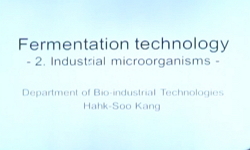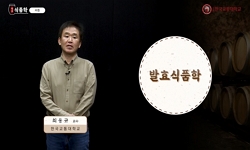In this study we investigated the change in antigenicity and allergenicity of Meju, a traditional Korean soybean product, by fermentation via 3 different microorganisms. The steamed soybeans were fermented with Lactococcus lactis subsp. lactis and/or ...
http://chineseinput.net/에서 pinyin(병음)방식으로 중국어를 변환할 수 있습니다.
변환된 중국어를 복사하여 사용하시면 됩니다.
- 中文 을 입력하시려면 zhongwen을 입력하시고 space를누르시면됩니다.
- 北京 을 입력하시려면 beijing을 입력하시고 space를 누르시면 됩니다.
https://www.riss.kr/link?id=A60225692
- 저자
- 발행기관
- 학술지명
- 권호사항
-
발행연도
2012
-
작성언어
Korean
- 주제어
-
등재정보
KCI등재,SCOPUS
-
자료형태
학술저널
- 발행기관 URL
-
수록면
1066-1071(6쪽)
-
KCI 피인용횟수
1
- DOI식별코드
- 제공처
- 소장기관
-
0
상세조회 -
0
다운로드
부가정보
다국어 초록 (Multilingual Abstract)
In this study we investigated the change in antigenicity and allergenicity of Meju, a traditional Korean soybean product, by fermentation via 3 different microorganisms. The steamed soybeans were fermented with Lactococcus lactis subsp. lactis and/or Aspergillus oryzae and/or Bacillus subtilis. Proteins in soybean were degraded after fermentation. Antigenicity or allergenicity were analysed by immunoblotting and ELISA using soybean protein-specific polyclonal antibodies or soybean allergic patient sera. The best degradation was achieved by three step fermentation using nisin-producing Lactococcus lactis subsp. lactis IFO12007, A. oryzae and B. subtilis. Allergenicity and antigenicity were also starkly reduced after three step fermentation. The three-step fermentation method developed in our lab suggests an excellent alternative to reduce the allergenicity of soybeans.
참고문헌 (Reference)
1 김세훈, "알레르기 증상으로 내원한 한국인에서의 음식물 알레르겐에 대한 감작율 조사: 다기관 공동연구" 대한천식알레르기학회 23 (23): 502-514, 2003
2 Samson HA, "Update on food allergy" 113 : 805-819, 2004
3 Kim JK, "The taste components of ordinary Korean soy sauce" 23 : 89-105, 1980
4 Awazuhara H, "Major allergens in soybean and clinical significance of IgG4 antibodies investigated by IgE- and IgG4-immunoblotting with sera from soybean-sensitive patients" 27 : 325-332, 1997
5 Lee CY, "Korean soy seasonings and culture" 22 : 3-7, 1989
6 Dalal I, "Food allergy is a matter of geography after all: sesame as a major cause of severe IgE-mediated food allergy reactions among infants and young children in Israel" 57 : 362-365, 2002
7 Beyer K, "Effects of cooking methods on peanut allergenicity" 107 : 1077-1081, 2001
8 Park CK, "Consumption pattern of Korean traditional soy sauce and consumer sensory evaluation" 11 : 521-526, 1995
9 Hill DJ, "Clinical spectrum of food allergy in children in Australia and South-East Asia: Identification and targets for treatment" 31 : 272-281, 1999
10 Bernhisel-Broadbent J, "Clinical relevance of altered fish allergenicity secondary to various preparation methods" 90 : 622-629, 1992
1 김세훈, "알레르기 증상으로 내원한 한국인에서의 음식물 알레르겐에 대한 감작율 조사: 다기관 공동연구" 대한천식알레르기학회 23 (23): 502-514, 2003
2 Samson HA, "Update on food allergy" 113 : 805-819, 2004
3 Kim JK, "The taste components of ordinary Korean soy sauce" 23 : 89-105, 1980
4 Awazuhara H, "Major allergens in soybean and clinical significance of IgG4 antibodies investigated by IgE- and IgG4-immunoblotting with sera from soybean-sensitive patients" 27 : 325-332, 1997
5 Lee CY, "Korean soy seasonings and culture" 22 : 3-7, 1989
6 Dalal I, "Food allergy is a matter of geography after all: sesame as a major cause of severe IgE-mediated food allergy reactions among infants and young children in Israel" 57 : 362-365, 2002
7 Beyer K, "Effects of cooking methods on peanut allergenicity" 107 : 1077-1081, 2001
8 Park CK, "Consumption pattern of Korean traditional soy sauce and consumer sensory evaluation" 11 : 521-526, 1995
9 Hill DJ, "Clinical spectrum of food allergy in children in Australia and South-East Asia: Identification and targets for treatment" 31 : 272-281, 1999
10 Bernhisel-Broadbent J, "Clinical relevance of altered fish allergenicity secondary to various preparation methods" 90 : 622-629, 1992
11 Laemmli UK, "Cleavage of structural proteins during the assembly of the head of bacteriophage T4" 227 : 680-685, 1970
12 Wieslander G, "Buckwheat allergy" 56 : 703-704, 2001
13 Son DY, "Allergenicity changes of soybean proteins by thermal treatment" 32 : 959-963, 2000
14 Bradford M, "A rapid and sensitive method for the quantitation of microgram quantities of protein utilizing the principle of protein-dye binding" 72 : 248-254, 1976
15 Shek LP, "A population-based questionnaire survey on the prevalence of peanut, tree nut, and shellfish allergy in 2 Asian populations" 126 : 324-331, 2010
동일학술지(권/호) 다른 논문
-
건조 방법에 따른 표고버섯의 항산화능과 항유전독성 효과
- 한국식품영양과학회
- 김민정(Min-Jung Kim)
- 2012
- KCI등재,SCOPUS
-
5주간의 고지방식이 섭취시 흰쥐의 에너지 대사 기질 이용과 식이지방에너지 평가에 관한 연구
- 한국식품영양과학회
- 황혜정(Hyejung Hwang)
- 2012
- KCI등재,SCOPUS
-
가격민감성 측정 기법을 이용한 대학생의 커피전문점 가격에 대한 인식 분석
- 한국식품영양과학회
- 김현아(Hyun-Ah Kim)
- 2012
- KCI등재,SCOPUS
-
- 한국식품영양과학회
- 조정은(Jungeun Cho)
- 2012
- KCI등재,SCOPUS
분석정보
인용정보 인용지수 설명보기
학술지 이력
| 연월일 | 이력구분 | 이력상세 | 등재구분 |
|---|---|---|---|
| 2023 | 평가예정 | 해외DB학술지평가 신청대상 (해외등재 학술지 평가) | |
| 2020-01-01 | 평가 | 등재학술지 유지 (해외등재 학술지 평가) |  |
| 2014-06-24 | 학회명변경 | 한글명 : 한국식품영양과학회지 -> 한국식품영양과학회영문명 : Journal of the Korean Society of Food Science and Nutrition -> The Korean Society of Food Science and Nutrition |  |
| 2014-04-02 | 학회명변경 | 한글명 : 한국식품영양과학회 -> 한국식품영양과학회지영문명 : 미등록 -> Journal of the Korean Society of Food Science and Nutrition |  |
| 2011-01-01 | 평가 | 등재학술지 유지 (등재유지) |  |
| 2009-01-01 | 평가 | 등재학술지 유지 (등재유지) |  |
| 2007-01-01 | 평가 | 등재학술지 유지 (등재유지) |  |
| 2005-01-01 | 평가 | 등재학술지 유지 (등재유지) |  |
| 2002-07-01 | 평가 | 등재학술지 선정 (등재후보2차) |  |
| 2000-01-01 | 평가 | 등재후보학술지 선정 (신규평가) |  |
학술지 인용정보
| 기준연도 | WOS-KCI 통합IF(2년) | KCIF(2년) | KCIF(3년) |
|---|---|---|---|
| 2016 | 1.03 | 1.03 | 1.13 |
| KCIF(4년) | KCIF(5년) | 중심성지수(3년) | 즉시성지수 |
| 1.18 | 1.2 | 1.993 | 0.21 |





 ScienceON
ScienceON DBpia
DBpia





